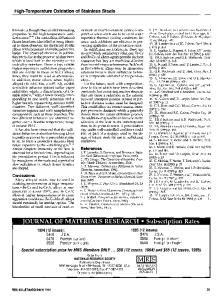Influence of boron nitride on reinforcement to improve high temperature oxidation resistance of titanium
- PDF / 994,330 Bytes
- 11 Pages / 584.957 x 782.986 pts Page_size
- 90 Downloads / 660 Views
Influence of boron nitride on reinforcement to improve high temperature oxidation resistance of titanium Jose D. Avila1 Amit Bandyopadhyay1,a)b) 1
W. M. Keck Biomedical Materials Research Lab, School of Mechanical and Materials Engineering, Washington State University, Pullman, Washington 99164, USA a) Address all correspondence to this author. e-mail: [email protected] b) This author was an editor of this journal during the review and decision stage. For the JMR policy on review and publication of manuscripts authored by editors, please refer to http://www.mrs.org/editor-manuscripts/. Received: 20 August 2018; accepted: 3 January 2019
Influence of boron nitride (BN) addition in commercially pure titanium (Cp-Ti) was characterized for their microstructural variation, hardness, and oxidation kinetics. Feedstock powders, Cp-Ti with 3 wt% BN (3BN) and 6 wt% BN (6BN), were prepared by roller mill followed by additive manufacturing using laser engineered net shaping (LENS™). Rate of oxidation was measured from thermogravimetric analysis (TGA) at 1000 °C for 50 h. Average instantaneous parabolic constants (kp) for Cp-Ti, 3BN, and 6BN were 41.2 ± 12.0, 28.6 ± 2.8, and 18.2 ± 9.2 mg2/(cm4 h), respectively. Cp-Ti displayed acicular a-Ti microstructure. After TGA, large equiaxed grains along with TiO2 formation at the grain boundaries were observed, which increased the hardness. With BN addition, plate-like TiN and needle-like TiB secondary phases were also observed. Hardness for Cp-Ti, 3BN, and 6BN were 256.9 ± 7.7, 424.0 ± 33.6, and 548.3 ± 49.7 HV0.2, respectively. Overall, a small addition of BN was effective in improving the oxidation resistance of Cp-Ti.
Introduction Titanium (Ti) is a silver colored transition metal with characteristics that make it attractive for widespread use in automotive, chemical, medical, and aerospace applications; characteristics such as high corrosion resistance, high strengthto-weight ratio, excellent fatigue resistance, and a relatively high melting point (.1650 °C) [1, 2, 3, 4, 5]. Specifically, for elevated temperature applications, Ti’s low thermal conductivity, high specific strength, and low thermal expansion [8.6 lm/(m K)] are key features. Additionally, Ti always has an outer oxide layer, titanium dioxide (TiO2), which is typically 4–5 nm in thickness [6]. The continuous and dense TiO2 passivation layer restricts the diffusion of oxygen into the bulk material. In this case, parabolic oxidation kinetics are observed up to 600 °C [7]. The assumption with parabolic oxidation kinetics is that diffusion of oxygen through the coherent oxide layer is the rate limiting step [8]. At higher temperatures (.600 °C), deterioration of the passivation layer occurs resulting in linear oxidation kinetics with continued and uncontrolled reaction or absorption of oxygen. Linear oxidation kinetics are a direct result of a cracked or porous
ª Materials Research Society 2019
oxide layer where transport of ions occurs faster than the chemical reaction [8]. Several surface treatment techniques have been im
Data Loading...










